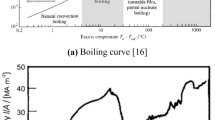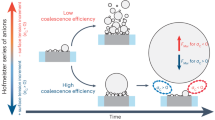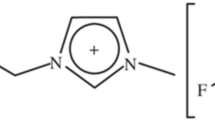Abstract
The hydrogen evolving system such as the water electrolysis generates hydrogen gas at the cathode surface via electrochemical reaction. The current density increases as the cell potential increases with the increased hydrogen generation rate. However, the current density is limited by the formation of hydrogen film on the surface, similar to the critical heat flux (CHF) condition, which is known as critical current density (CCD). Unlike to the boiling system, the influences of hydrodynamic parameters on the CCD is hardly investigated. The present work is motivated by the fact that the CHF is affected by the surface tension. In the present work, the water electrolysis of sulfuric-acid aqueous solution was used to measure the CCD varying the surface tension via surfactant (CTAB). Comparative analyses were performed with the existing results of the boiling system. Both the CCD and hydrogen bubble diameter decreased as the surface tension decreased, similar to those of the boiling system. To investigate relationship between the CCD and the hydrogen bubble diameter, the bubble velocity was estimated by the measured CCD, which is affected by the bubble diameter, the drag coefficient and gas area fraction. Using those parameters, the CCD is predicted within 20% error. The result implies that the influence of surface tension on the CCD is similar to that on the CHF.










Similar content being viewed by others
Abbreviations
- A :
-
Surface area [m2]
- A R :
-
Gas area fraction
- C :
-
Concentration of surfactant in bulk liquid [ppm]
- C d :
-
Drag coefficient
- D :
-
Bubble diameter [mm]
- F :
-
Faraday constant [C/mol]
- g :
-
Acceleration of gravity [m/s2]
- h fg :
-
Latent heat [kJ/kg]
- I˝ :
-
Current density [A/m2]
- I˝ CCD :
-
Critical current density [A/m2]
- m :
-
Molar mass [mol/kg]
- q" :
-
Heat flux [kW/m2]
- q" CHF :
-
Critical heat flux [kW/m2]
- R a :
-
Roughness average [μm]
- Re :
-
Reynolds number
- S :
-
Electric conductance [Ω−1]
- v :
-
Bubble velocity [m/s]
- v g :
-
Critical gas velocity [m/s]
- v s :
-
Superficial velocity [m/s
- ρ :
-
Density [kg/m3
- g :
-
Gas
- l :
-
Liquid
- exp :
-
Experimental measurement
- pred :
-
Prediction value
- b :
-
Bubble
- hex :
-
Hexagonal
References
Liang G, Mudawar I (2018) Pool boiling critical heat flux (CHF) – Part 1: Review of mechanisms, models, and correlations. Int J Heat Mass Transf 117:1352–1367. https://doi.org/10.1016/j.ijheatmasstransfer.2017.09.134
O’Hanley H, Coyle C, Buongiorno J, McKrell T, Hu LW, Rubner M (2013) Separate effects of surface roughness, wettability and porosity on the boiling critical heat flux. Appl Phys Lett 103:024102. https://doi.org/10.1063/1.4813450
Zuber N (1959) Hydrodynamic aspects of boiling heat transfer. Dissertation, University of California
Haramura Y, Katto Y (1983) A new hydrodynamic model of critical heat flux, applicable widely to both pool and forced convective boiling on submerged bodies in saturated liquids. Int J Heat Mass Transf 117:389–399. https://doi.org/10.1016/0017-9310(83)90043-1
Raza MQ, Kumar N, Raj R (2018) Wettability-independent critical heat flux during boiling crisis in foaming solutions. Int J Heat Mass Transf 126:567–579. https://doi.org/10.1016/j.ijheatmasstransfer.2018.05.062
Dolatabadi S, Fattahi M, Nabati M (2021) Solid state dispersion and hydrothermal synthesis, characterization and evaluations of TiO2 /ZnO nanostructures for degradation of Rhodamine B. 231:425–435. https://doi.org/10.5004/dwt.2021.27496
Garmroudi A, Kheirollahi M, Mousavi SA, Fattahi M (2020) Effects of Graphene oxide/TiO2 nanocomposite, graphene oxide nanosheets and Cedr extraction solution on IFT reduction and ultimate oil recovery from a carbonate rock. J Petroleum. https://doi.org/10.1016/j.petlm.2020.10.002
Sillen CWMP, Barendrecht E, Janssen LJJ, Van Stralen SJD (1982) Gas bubble behaviour during water electrolysis. Int J Hydrog Energy 7:577–587. https://doi.org/10.1016/0360-3199(82)90038-6
Vogt H, Aras I, Balzer RJ (2004) The limits of the analogy between boiling and gas evolution at electrodes. Int J Heat Mass Transf 47:787–795. https://doi.org/10.1016/j.ijheatmasstransfer.2003.07.023
Gangal U, Srivastava M, Sen Gupta SK (2009) Mechanism of the Breakdown of Normal Electrolysis and the Transition to Contact Glow Discharge Electrolysis. J Electrochem Soc 156:131–136. https://doi.org/10.1149/1.3186023
Daring HE (1964) Conductivity of sulfuric acid solutions. J Chem Eng Data 9:421–426. https://doi.org/10.1021/acsnano.1c09622
Petkova B, Tcholakova S, Chenkova M, Golemanov K, Denkov N, Thorley D, Stoyanov S (2020) Foamability of aqueous solutions: Role of surfactant type and concentration. Adv Colloid Interface Sci 276:102084. https://doi.org/10.1016/j.cis.2019.102084
Owens DK, Wendt RC (1969) Estimation of the surface free energy of polymers. J Appl Polym Sci 13:1741–1747. https://doi.org/10.1002/app.1969.070130815
Coleman HW, Steele WG (1999) Experimentation and uncertainty analysis for engineers. John Wiley & Son Inc., Canada
Raza MQ, Kumar N, Raj R (2016) Surfactants for Bubble Removal against Buoyancy. Sci Rep 6:19113. https://doi.org/10.1038/srep19113
Andrianov A, Farajzadeh R, Mahmoodi Nick M, Talanana M, Zitha PLJ (2012) Immiscible foam for enhancing oil recovery: bulk and porous media experiments. Ind Eng Chem Res 51:2214–2226. https://doi.org/10.1021/ie201872v
Ferri JK, Stebe KL (2000) Which surfactants reduce surface tension faster? A scaling argument for diffusion-controlled adsorption. Adv Colloid Interface Sci 85:61–97. https://doi.org/10.1016/S0001-8686(99)00027-5
Kugou N, Ishida K, Yoshida A (2003) Experimental study on motion of air bubbles in seawater (terminal velocity and drug coefficient of air bubble rising in seawater). WIT Transactions on the Built Environment 68:145–158. https://doi.org/10.2495/MT030141
Yang G, Zhang H, Luo J, Wang T (2018) Drag force of bubble swarms and numerical simulations of a bubble column with a CFD-PBM coupled model. Chem Eng Sci 192:714–724. https://doi.org/10.1016/j.ces.2018.07.012
Hassan NMS, Khan MMK, Rasul MG (2008) A Study of Bubble Trajectory and Drag Co-efficient in Water and Non-Newtonian Fluids. Wseas transactions on fluid mechanics 3:261–270
Tao F, Ning S, Zhang B, Jin H, He G (2019) Simulation study on gas holdup of large and small bubbles in a high pressure gas–liquid bubble column. Processes 7:594. https://doi.org/10.3390/pr7090594
Acknowledgements
This study was sponsored by the Ministry of Science and ICT and was supported by Nuclear Research & Development program grant funded by the National Research Foundation (NRF) (Grant code: 2017M2A8A4015283).
Author information
Authors and Affiliations
Corresponding author
Additional information
Publisher's Note
Springer Nature remains neutral with regard to jurisdictional claims in published maps and institutional affiliations.
Rights and permissions
About this article
Cite this article
Park, DH., Park, HK. & Chung, BJ. Influence of surface tension on the critical current density at sulfuric acid electrolysis. Heat Mass Transfer 58, 2097–2105 (2022). https://doi.org/10.1007/s00231-022-03230-1
Received:
Accepted:
Published:
Issue Date:
DOI: https://doi.org/10.1007/s00231-022-03230-1




